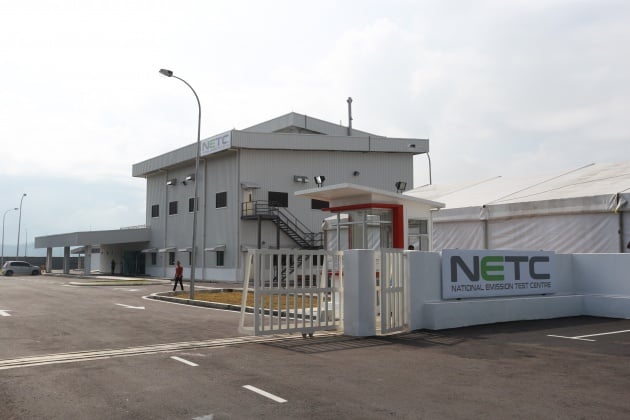Now many know about this, and many who do might have forgotten about it, but we have a National Emission Test Centre (NETC) located in Sg Choh. Located just north of Rawang, the NETC is adjacent to Perodua’s factory and is described as the first full-fledged emissions testing facility in Malaysia.
The location is no coincidence – the RM50 million investment in NETC was borne by Perodua, but the centre is managed by the Malaysia Automotive, Robotics & IoT Institute (MARii), and is open to all vehicle manufacturers in Malaysia and ASEAN, which prior to the NETC’s opening in 2018, had no option to do emissions testing locally.
NETC’s facilities include real-time measurement of exhaust emission gases for passenger cars in accordance with UN Regulation 83 and 101, and up to Euro 6b and 6c levels. The emissions lab is equipped with an Emissions Chassis Dynamometer within a climatic chamber. The centre also features a soak room, emissions and equipment room and a control room.
However, as we move from internal combustion engines (ICE) to electric vehicles (EVs), which have zero emissions at the tailpipe, will NETC be redundant? That’s a valid question as ’emissions’ is in the facility’s name, but NETC says that it has a role to play beyond emissions when it comes to EVs.
To cut to the chase – testing electric range and energy consumption (EC), the EV equivalent of fuel consumption. Aside from emissions testing, NETC’s says that its key services include measuring FC, EC and range to UNR101 standards. The centre can also conduct testing for vehicle type approval (VTA), energy efficient vehicles (EEV) and conformity of production.
At the ongoing International Electric Mobility Showcase, which is part of the International Greentech & Eco Products Exhibition & Conference Malaysia (IGEM) 2023 event at the KL Convention Centre, NETC claims that it is the most advanced facility in ASEAN for testing vehicle emissions, EC and range. The latter is important to ‘avoid false declaration by manufacturers’ and to boost ‘consumer confidence and (EV) adoption’.
“NETC serves as a meticulous testing ground, analysing energy consumption and kilometre range of EVs in diverse conditions. This data empowers manufacturers, policymakers and consumers, ensuring EVs exceed expectations, bolstering confidence and fuelling market growth,” NETC said.
“Our commitment to excellence ensures that every EV on the road meets not only environmental standards but also consumer expectations. NETC is not only recognised in Malaysia but has been recognised as a ‘global laboratory’ by United Nations and all reports can be used for international trade facilitation as one of the initiatives to remove technical barriers to trade,” it adds.
When it comes to consumer trust, we totally get NETC’s point of view (remember Dieselgate?), but all cars sold here would already have EC and range figures from their home markets or other markets where the cars are sold, such as WLTP of CLTC. NETC would probably counter with the point that Malaysia has unique conditions and driving styles.
So, the question is who do you trust more – manufacturer claims based on overseas standards or local testing?
Looking to sell your car? Sell it with Carro.







Why Paultan writers always this delusional? ICE vehicle is here to stay and coexist with BEV. Such question should never be ask in the first place.
not just PT, other automotive medias are also the same so normies can easily be brainwashed
You are wasting oxygen so we gonna switch off your mitochondrial
ATP?
Unless the local manufacturers are planning to develop their own tech (not likely). They could lobby the government to make it a compulsory test for vehicles to be sold here, which would not be a popular move for manufacturers not named Perodua.
Currently, they are the only facility that is designated for UNR R101. For R83, we also designated Applus+ IDIADA & TuV Rheinland, both outside facilities.
Designation of Listed Technical Service(s)
1. Applus+ IDIADA
Category(A/B/C/D): A,B,C,D
ISO Accreditation: ISO 17025, ISO 17021 & ISO 17020
UNRs under APMRA: R13, R13H, R14, R16, R17, R25, R28, R30, R39, R40, R41, R49, R43, R46, R51, R54, R75, R79, R83
Testing facility in Malaysia: –
2. TuV Rheinland (Malaysia)
Category(A/B/C/D): A,B,C,D
ISO Accreditation: ISO 17025, ISO 17021 & ISO 17020
UNRs under APMRA: R13, R13H, R14, R16, R17, R25, R28, R30, R39, R40, R41, R49, R43, R46, R51, R54, R75, R79, R83
Testing facility in Malaysia: –
3. National Emission Test Centre (NETC)
Category(A/B/C/D): A
ISO Accreditation: ISO 17025
UNRs under APMRA: R83
Testing facility in Malaysia: for UN Regulation (R83 & R101)
4. SIRIM QAS International Sdn.Bhd
Category(A/B/C/D): A,B
ISO Accreditation: ISO 17025
UNRs under APMRA: R10
Testing facility in Malaysia: for EMC (component and vehicle)
5. Rubber Research Institute of Malaysia (RRIM)
Category(A/B/C/D): A,B
ISO Accreditation: ISO 17025
UNRs under APMRA: R30, R54, R75
Testing facility in Malaysia: for pneumatic tyre (UNR, MS, FMVSS)
Local testing good to double check claims made by any manufacturer.
Good job Perodua able to spend own money RM50 million because they’re successful and highly profitable company unlike the other one which is embarassingly a national failure.
for Battery car, we need EV test lab to measure km/kWH especially at highway speed of 110km/h, with slope gradient to compare efficiency.
Agree. Useless nonsense article. Petrol engine is best and here to stay. EV just move pollution to different chain in the car making process. EV won’t be practical until you can charge your car full in 5 minutes and without having to kill other drivers at the charging station in order to have a chance at charging your car. Paul Tan is utter rubbish.
Dead like covid testing centre at MEX highway rnr
Wasting money n resources, better spent the money for other benefit use.
Another dept which is gaji buta on top of all the university research centers… look at Japan’s RnD and Elon Musk RnD
1. https://www.youtube.com/watch?v=_w3APY5cAtM
2. https://www.youtube.com/watch?v=98ZhoBTu2PQ
3. https://www.youtube.com/watch?v=DGL5g91KwLA